
Thermoluminescence Study of Based Materials of Ceramic Tiles
AbstractMany flooring materials most of them are in natural form are used to manufacture floor tiles for household flooring purpose. The peoples demand for variety of flooring material Leeds to develop various types of ceramic tiles. In India ceramic industry is fast growing one, more then 400 units of manufacturing ceramic tiles, vitrified tiles and sanitary ware, situated around Morbi, Rajkot, Gujarat, India. Many natural minerals are used as the raw materials required for the manufacturing ceramic ware. The following minerals are used to manufacturing the ceramic tiles i.e. Quartz, Feldspar, Zircon, Talc, Grog, Alumina oxide, etc. Most of the minerals are from Indian mines of Gujarat and Rajasthan states, some of are imported from Russian sub continent. The present paper reports the thermoluminescence (TL) characteristics of Feldspar, Alumina and Quartz minerals collected from the ceramic tiles manufacturing unit, Morbi. The as received minerals Natural TL was recorded (NTL), and annealed and quenched from 200oC, 420oC and 8200C followed by 15Gy beta dose given from Sr-90 beta source TL was recorded and the comparative TL (Thermoluminescence) study of above materials are presented. The characterization of the minerals is done using TGA and XRD studies.
Keywords: NTL – Natural Thermoluminescence,TL- Thermoluminescence
Many natural mineral are used to manufacture floor tiles for household floorings. The demand of a variety of flooring materials has lead to develop various types of ceramic tiles. In India the ceramic industry is one of the fastest growing industries, more then 200 major manufacturing units of ceramic tiles, vitrified tiles and sanitary wares are situated at Morbi (Rajkot District, Gujarat state, India). Many natural minerals are used as the raw materials for the manufacturing ceramic wares. The minerals used in manufacturing the ceramic tiles are Quartz, Feldspar, Zircon, Talc, Frit-O, Frit-T, Aluminum oxide, Sodium trypoly phosphate China clay, Bikaner clay, etc. Most of the minerals are from mines in Gujarat and few are from Rajasthan state and imported from Russia. The phenomenon of TL has been studied by many investigators. The thermoluminescence (TL) study in geology, particularly for natural minerals, is an important research tool. The TL study of minerals commonly used in ceramic tiles industry, such as feldspar and Zircon gives better understanding about their properties. The systematic study of TL of such minerals is helpful to solve the basic raw materials quality problem the ceramic tiles industries[1,2].
Experimental method:The The natural minerals used in manufacturing ceramic tiles are collected from the industry. Most of the materials used for the TL analysis were indigenous minerals and a few were imported minerals. TL of these minerals was recorded using TL set-up supplied by Nucleonix Systems, Hyderabad [3,4]. Irradiation was carried using Sr-90 beta source. Equal quantities of weighed samples (5 mg) were used for the analysis. Heating rate used for all the TL measurements was 4oC/Sec.
Results and discussion:TL Study of Quartz:
Fig.1 curves 1,2,3 are the TL of 5mg of weighed powder of Quartz annealed and quenched from 200, 420 and 820oC. There is not much NTL was observed and alsos with 15Gy beta irradiation. Fig.1 curves 1,2,3 are the TL glow curve of quartz irradiated with beta dose of 15 Gy using Sr90. Here one broad peak occurs at temperature 110oC and intensity of 1.83au for 200AQ . 40au for 420AQ and 100au for 820AQ.
Fig.1: Curve 1 is the TL of 15Gy beta dose natural quartz annealed and quenched form 200oC.
Curve 2 is the TL of 15Gy beta dose natural quartz annealed and quenched form 420oC.
Curve 3 is the TL of 15Gy beta dose natural quartz annealed and quenched form 820oC.
TL glow curve of 420oC and 840oC AQ sample of Quartz exhibits one well resolved and isolated TL peak with high intensity around 100oC. This peak is interesting TL peak in dosimetric point of view.

Fig. 2 shows the NTL glow curve of Feldspar mineral with out any pre heat treatment and irradiation .The glow curve exhibits one well resolved peak at 3080C temperature, here heating rate is 4OC/sec for TL measurement the intensity of peak is 76au noted this intensity is remarkable this sample gives TL without any pre heat treatment this result is interesting here phase changed thermoluminescence may occurs. Some mineral contain water molecule due to this result the phase change TL produced. Here till temperature 170oC the intensity remain near to zero but then after intensity continuously increasing with temperature .From this result it is noted that one trap with large numbers of carriers generated peak at 308oC.
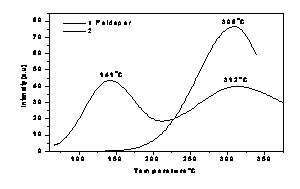
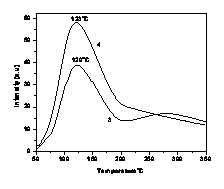
Fig. 2 : Curves 1,2, 3 and 4 are the NTL, 200, 420 and 820AQ of Feldspar
Fig. 2 curve 2 is the TL glow curve of Feldspar mineral irradiated with beta dose of 15 Gy using Sr90 here no any pre heat treatment is given to the sample, here two well resolved glow peak occurs at temperature 141oC and 312oC which indicates that two different traps with large number of carriers are present leads to related traps when heating in the temperature range from 50-350oC with intensity of peaks 43au and 39au respectively.
Fig. 2 curve 3 and 4 are the TL glow curve of Feldspar mineral with pre heated at annealing and quenching temperature from 420 and 820oC. One well resolved glow peak occurs around 123oC with peak intensity 39au for 420AQ and 60au intensity for 820AQ sample.
Fig. 3 shows the glow curve of Alumina treated with annealing and quenching temperature of 4200C and irradiated with beta source of 15 Gy .here glow curve exhibits one well resolved peak at temperature 2750C and intensity of 48au also one broad hump is developed.
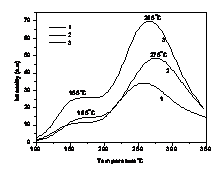
Fig. 3 : Curves 1,2, and 3 are the TL of 200, 420 and 820AQ of alumina (Al2O3)
AQ, 50au for 420AQ and 70au for 820oC AQ specimens of alumina. It is noted that after annealing and quenching followed by irradiation the intensity of TL is increased which s means that that large carriers oriented traps are generated. It is also observed a low intensity broad hump is observed around 150oC in all three curves.
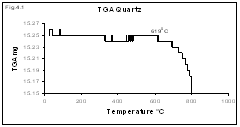
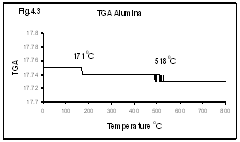
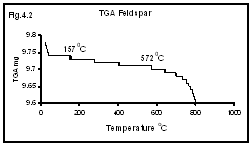
Fig.4.1,2 and 3 are the TGA of Quartz, Feldspar and Alumina.
Fig.4.1 is the TGA of Quartz. From the TGA it is clear that variation seen in phase between temperature range 4200C and 8200C. As we observed in TL the TL intensity is decreased between this temperature ranges due to phase change. Fig.4.2 is the TGA of Feldspar which continuously changes its phases by releasing the water molecules and dissociating. Fig.4.3 is the TGA of alumina which changes its phases by releasing the water molecules around 170oC and not much change observed in TGA. However the TL intensity increase when annealed and quenching from 820oC because of heat treatment causes many defects creation in the crystal lattice.
Fig.5 the XRD pattern of Quartz it is clearly matches with the standard peaks observed at 26.66, 20.88, 50.18 and 60 o are major peaks of standard Quartz sample.
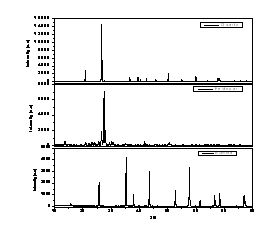
From the observed XRD pattern of Natural Quartz, Feldspar and Alumina it is clearly seen the peaks are very isolated and intense and matches with the standard peaks. This indicates the minerals are mostly pure with out any inclusions. The results are mostly matching with observations of earlier workers [5-12]. These minerals can be used fro TL dosimetry studies.
CONCLUSION :
The natural TL [NTL] observed in above minerals under study as well as NTL+ATL followed by the TL observed from annealed and quenched form 420oC and 8400C followed by beta irritation leads to the conclusions that the results are due to the traps formed due to irradiation as well as heat treatment subjected to the mineral.
The systemic study may be more useful in checking the purity of the raw materials which in turn leads to improving the quality of ceramic tiles in ceramic industries. Further studies on TL dosimetry are in progress.
REFERENCES :
***************************************************
H.C.Mandavia
Shri M. M. Science College,
Morbi
Applied Physics Department
M. S. University, Baroda
Joint Director , Commissioner of Higher Education, Gujarat State , Gandhinagar
R.P.Shah
Government Science College,Valod
A.N.Sayani
College of Fisheries,JAU, Veraval



Home | Archive | Advisory Committee | Contact us